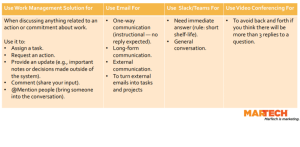CMOs starting new roles during the pandemic share how they are reworking the B2B marketing playbook and shifting team talent to meet the changing times.
“I expected to be filling out HR forms and having coffee with people during Week 1. Instead, I was leading significant, cross-company customer communications. The marketing team gained significant visibility.”
Jay Roxe started as CMO at cybersecurity company BitSight on March 16. His first day was spent – no surprise! — working from home.
I spoke with him, and with other marketing leaders starting new roles in the midst of the pandemic. They shared how they are tackling their roles, how they are re-jiggering the B2B marketing playbook, and how they are allocating their time.
Here are some themes that emerged, on both the doing of marketing and the leading. If you are also stepping into a new or expanded marketing leadership role, these tips may help you.
Doing
1. Apply your beginner’s eye. The marketers most likely to be guilty of tone-deaf communications are the ones who have been in place for a long time. As the new marketing leader, you offer a fresh perspective – which lowers the risk of unwittingly putting off your audience. Shashi Bellamkonda is the brand-new VP of Marketing for Leap, the sales software company for home improvement companies. He shares: “The content we create has to be helpful and take into account the sensitivities around the situation.”
2. Love the leads you’ve got. Claudine Bianchi, the brand new CMO of SaaS company LeanIX, which serves enterprise architects, shares: “As we look into Q2, we won’t be hitting our MQL numbers. But we still have to hit our sales numbers. So we are changing the objectives away from MQLs and brand awareness. We’re thinking of how to nurture the opportunities in the pipeline already. We are going through every single lead and asking, ‘What are the things we should be doing to advance the buyer journey?’”
3. Think big with customer marketing. As you shift from classic lead gen to customer-focused marketing, you have the opportunity to think fresh about what will make your customers successful. What acts of heroic customer support, or customer empathy, can you inspire and reward? Remember that these random acts of empathy could come from anywhere in the org, not necessarily marketing or customer success.
4. Revisit your budget. Some marketing leaders are zero-basing their marketing budgets. Jay Roxe shared his approach for his events budget in particular: “The degree of spend that we have had on events and other face-to-face marketing is not going to go back to where it was for a while. We need to determine how virtual events will perform relative to the planned physical events.”
5. Tackle your “important but not urgent” bucket. Balance the intensity of your urgent work — crisis communications, for instance — with the calm purpose and fulfillment that comes from advancing your important foundational priorities. As Shashi Bellamkonda says, “Under normal circumstances, most businesses have a to-do list of upgrades and efficiency projects that they may put off. This is a good time to set up systems and processes to scale. It is an excellent time for marketing teams to audit their activity and presence and make changes.”
Claudine Bianchi agrees. “Instead of being reactive, how can you be more deliberate about planning campaign strategy, about messaging strategy? Look at your value propositions; do they still resonate? Look at your personas. Have they been updated? When was the last time you talked to a customer? Now there is some time to contemplate and not just rush around doing unnecessary things.”
6. Draw inspiration from the best virtual events – the ones that “grab from the get-go.” You may be feeling ‘virtual conferenced out,’ but you can still pay attention to what the best virtual events can teach you. Maybe that live-streamed yoga class will inspire your next online customer event. Claudine Bianchi shares, “We’ve learned to keep things short. The topics have to be like TED Talks – 10 minutes or so. We are learning to grab our audience from the get-go. Actually, this will make us better presenters when this is over.”
7. Embrace the productivity. Rejoice! So many marketing leaders work in open offices with a constant stream of “Can I grab you for a minute?” and “Did you know that this page on the website isn’t loading?” Now, you are alone and those interruptions interactions are more scheduled. Translation: you can get a lot more done.
Leading
8. Consider hosting open office hours. “I’m new to the business,” says Jay Roxe. “No one on the team knows who I am, what I believe in, and why they should trust me. Office hours provide an opportunity for the team to get to know me, surface problems, and say things like, ‘Hey, have you thought about this new avenue for partnerships or this new play for an international market?’” Office hours can be just that – open and optional. The key is to have the time and space set aside for talking about things that don’t necessarily fit into a specific current workstream.
9. Hire from anywhere. You will see pretty soon who steps up and gets stuff done, and who the lower performers are. At the same time, you will have more ammunition for hiring remotely than ever before: After all, a month ago, your company may have been adamant about people only working in the office. Now though, we are all getting used to remote work. If working from anywhere is working out better than you thought, you can now turn your sights on hiring the best marketing talent, regardless of where they are.
10. Over-communicate, and channel the nervous energy. “Focus on your team, and reassure them of your support,” Shashi Bellamkonda says. “It is not easy for them to face this situation and to also have a new leader.” Realize that you are there to dispel the ambiguity for your team. This is also a good time to brainstorm about bigger-picture things since activity and positivity are a salve for nervous, unharnessed energy.
In this vein, Jay Roxe is driving the team with the mission of ‘Compassion, Communication and Action.’ He shares, “Accept that people need to work differently, over-communicate across the business, and never lose track of the fact that it’s more important than ever to drive renewals, upsells, and opportunities.”
11. Think human and humor, both with your team and with your customers. In challenging times, we can connect as people first, and show a bit more vulnerability. Claudine Bianchi observes, “We will all be seeing a lot of messages about ‘this is the time to save money.’ Maybe, but this is an opportunity to be a little lighter, and inject more human-ness.”
The marketing function itself is inherently extroverted – even if the people doing it are not. After all, B2B marketing is shuttle diplomacy – navigating among sales, product, finance, and customer success. When you don’t have the in-person “bump effect” to help you establish and steer the relationships you need to be effective, and when the B2B marketing playbook needs revisiting, you can still get a good start in your new role. Go forth, brand new marketing leaders.
Opinions expressed in this article are those of the guest author and not necessarily Marketing Land. Staff authors are listed here.
Marketing Land – Internet Marketing News, Strategies & Tips
(20)
Report Post





